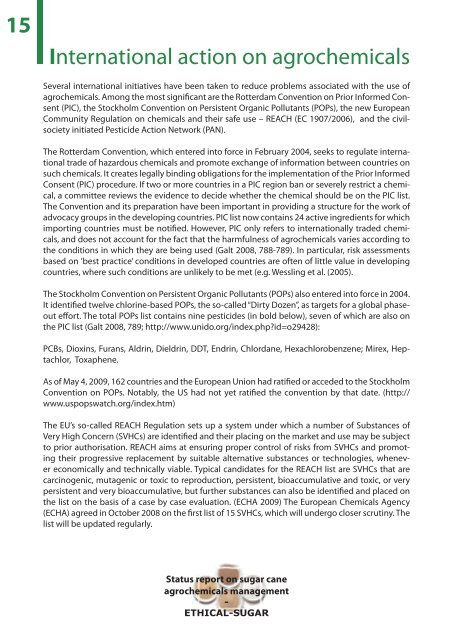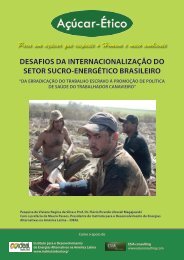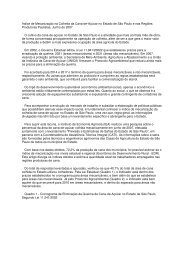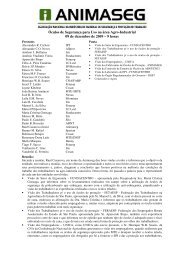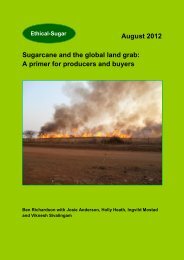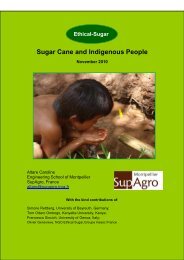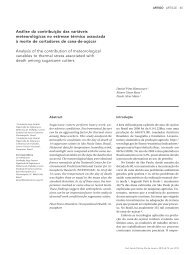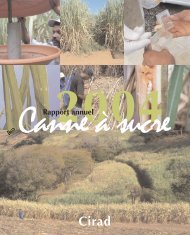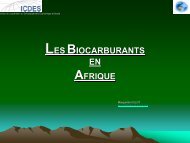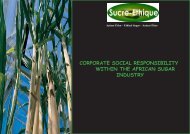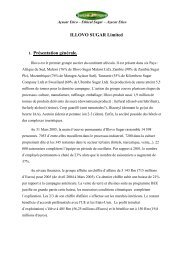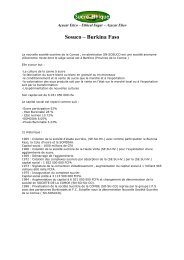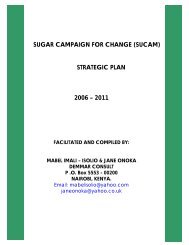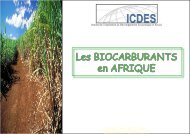Status report on sugar cane agrochemicals ... - Sucre Ethique
Status report on sugar cane agrochemicals ... - Sucre Ethique
Status report on sugar cane agrochemicals ... - Sucre Ethique
You also want an ePaper? Increase the reach of your titles
YUMPU automatically turns print PDFs into web optimized ePapers that Google loves.
15<br />
Internati<strong>on</strong>al acti<strong>on</strong> <strong>on</strong> <strong>agrochemicals</strong><br />
Several internati<strong>on</strong>al initiatives have been taken to reduce problems associated with the use of<br />
<strong>agrochemicals</strong>. Am<strong>on</strong>g the most signi� cant are the Rotterdam C<strong>on</strong>venti<strong>on</strong> <strong>on</strong> Prior Informed C<strong>on</strong>sent<br />
(PIC), the Stockholm C<strong>on</strong>venti<strong>on</strong> <strong>on</strong> Persistent Organic Pollutants (POPs), the new European<br />
Community Regulati<strong>on</strong> <strong>on</strong> chemicals and their safe use – REACH (EC 1907/2006), and the civilsociety<br />
initiated Pesticide Acti<strong>on</strong> Network (PAN).<br />
The Rotterdam C<strong>on</strong>venti<strong>on</strong>, which entered into force in February 2004, seeks to regulate internati<strong>on</strong>al<br />
trade of hazardous chemicals and promote exchange of informati<strong>on</strong> between countries <strong>on</strong><br />
such chemicals. It creates legally binding obligati<strong>on</strong>s for the implementati<strong>on</strong> of the Prior Informed<br />
C<strong>on</strong>sent (PIC) procedure. If two or more countries in a PIC regi<strong>on</strong> ban or severely restrict a chemical,<br />
a committee reviews the evidence to decide whether the chemical should be <strong>on</strong> the PIC list.<br />
The C<strong>on</strong>venti<strong>on</strong> and its preparati<strong>on</strong> have been important in providing a structure for the work of<br />
advocacy groups in the developing countries. PIC list now c<strong>on</strong>tains 24 active ingredients for which<br />
importing countries must be noti� ed. However, PIC <strong>on</strong>ly refers to internati<strong>on</strong>ally traded chemicals,<br />
and does not account for the fact that the harmfulness of <strong>agrochemicals</strong> varies according to<br />
the c<strong>on</strong>diti<strong>on</strong>s in which they are being used (Galt 2008, 788-789). In particular, risk assessments<br />
based <strong>on</strong> ’best practice’ c<strong>on</strong>diti<strong>on</strong>s in developed countries are often of little value in developing<br />
countries, where such c<strong>on</strong>diti<strong>on</strong>s are unlikely to be met (e.g. Wessling et al. (2005).<br />
The Stockholm C<strong>on</strong>venti<strong>on</strong> <strong>on</strong> Persistent Organic Pollutants (POPs) also entered into force in 2004.<br />
It identi� ed twelve chlorine-based POPs, the so-called “Dirty Dozen”, as targets for a global phaseout<br />
e� ort. The total POPs list c<strong>on</strong>tains nine pesticides (in bold below), seven of which are also <strong>on</strong><br />
the PIC list (Galt 2008, 789; http://www.unido.org/index.php?id=o29428):<br />
PCBs, Dioxins, Furans, Aldrin, Dieldrin, DDT, Endrin, Chlordane, Hexachlorobenzene; Mirex, Heptachlor,<br />
Toxaphene.<br />
As of May 4, 2009, 162 countries and the European Uni<strong>on</strong> had rati� ed or acceded to the Stockholm<br />
C<strong>on</strong>venti<strong>on</strong> <strong>on</strong> POPs. Notably, the US had not yet rati� ed the c<strong>on</strong>venti<strong>on</strong> by that date. (http://<br />
www.uspopswatch.org/index.htm)<br />
The EU’s so-called REACH Regulati<strong>on</strong> sets up a system under which a number of Substances of<br />
Very High C<strong>on</strong>cern (SVHCs) are identi� ed and their placing <strong>on</strong> the market and use may be subject<br />
to prior authorisati<strong>on</strong>. REACH aims at ensuring proper c<strong>on</strong>trol of risks from SVHCs and promoting<br />
their progressive replacement by suitable alternative substances or technologies, whenever<br />
ec<strong>on</strong>omically and technically viable. Typical candidates for the REACH list are SVHCs that are<br />
carcinogenic, mutagenic or toxic to reproducti<strong>on</strong>, persistent, bioaccumulative and toxic, or very<br />
persistent and very bioaccumulative, but further substances can also be identi� ed and placed <strong>on</strong><br />
the list <strong>on</strong> the basis of a case by case evaluati<strong>on</strong>. (ECHA 2009) The European Chemicals Agency<br />
(ECHA) agreed in October 2008 <strong>on</strong> the � rst list of 15 SVHCs, which will undergo closer scrutiny. The<br />
list will be updated regularly.<br />
<str<strong>on</strong>g>Status</str<strong>on</strong>g> <str<strong>on</strong>g>report</str<strong>on</strong>g> <strong>on</strong> <strong>sugar</strong> <strong>cane</strong><br />
<strong>agrochemicals</strong> management<br />
-<br />
ETHICAL-SUGAR


